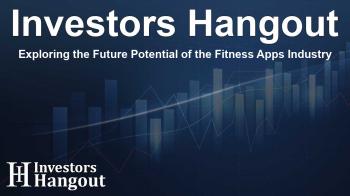Exploring the Future Potential of the Fitness Apps Industry

The Growth Trajectory of Fitness Apps
The fitness apps market is on a remarkable journey, projected to grow from USD 10.58 billion in 2024 to an astonishing USD 30.28 billion by 2032. This remarkable increase, representing a compound annual growth rate (CAGR) of 14.13%, showcases the transformative impact of technology on wellness and fitness. The U.S. market, specifically, is anticipated to see its size grow from USD 3.76 billion in 2024 to approximately USD 10.65 billion by 2032, further driving the demand for innovative digital wellness solutions.
Understanding the Factors Driving Growth
The growth in the fitness apps market is propelled by several interconnected trends. The integration of artificial intelligence in fitness applications is a game-changer, providing personalized coaching to users based on their unique health data. Businesses are rapidly adopting corporate wellness programs that encourage the use of these digital solutions, which contribute to healthier work environments and ultimately aim at reducing healthcare costs associated with lifestyle diseases.
Market Insights and Trends
Fitness applications encompass a variety of functionalities from workout tracking to meal planning and even mental health support, revolutionizing the approach to both physical and mental well-being. By utilizing machine learning algorithms, these platforms offer hyper-personalized experiences, enhancing user engagement and motivation.
The Role of Wearable Technology
Wearable technology, including devices like smartwatches and fitness bands, plays a pivotal role in this landscape. These gadgets sync seamlessly with fitness applications, allowing users to monitor their health metrics in real time. The rise of this technology has been noticeable in the U.S. market, fostering partnerships between app developers and gyms, enhancing user experience through hybrid fitness programs that blend physical and virtual sessions.
Key Players in the Market
Several key players dominate the fitness apps market, including names like Adidas, Nike, Fitbit (Google), MyFitnessPal, and Peloton. These companies are at the forefront of the industry, each bringing unique features and services to the table that cater to various segments of the fitness community.
Emerging Segment Analysis
The exercise and weight loss segment held a significant market share, accounting for 59.20% of the fitness apps landscape. This demand is largely a response to the increasing prevalence of sedentary lifestyles and the push toward healthier choices. Features such as customized training plans and interactive progress tracking have made these apps indispensable for users aiming to achieve their fitness goals.
Market Segmentation
When analyzing the fitness apps market, several segments stand out:
- Exercise & Weight Loss
- Diet & Nutrition
- Activity Tracking
Moreover, the platform breakdown indicates that Apple’s iOS accounts for a major share of the market, with 71.25% attributed to iOS users. This dominance can be linked to the strong Apple ecosystem, which encourages app usage through devices like the Apple Watch.
Regional Insights and Forecasts
North America currently leads the fitness apps market, attributed to widespread smartphone adoption and ingrained fitness cultures. However, the Asia-Pacific region is forecasted to register the fastest growth due to increased access to the internet, a surge in health awareness, and demographic trends that favor fitness.
Challenges and Opportunities Ahead
Despite the optimism surrounding fitness apps, challenges remain. Competition in the market is fierce, with many brands vying for the attention of users. Therefore, the successful companies will be the ones that continuously innovate while ensuring they do not compromise user experience. This highlights the importance of adapting to user feedback and technological advancements.
The Future is Personalization
Looking ahead, the emphasis on personalized health and fitness solutions is likely to shape the future of the fitness apps industry. With the continued rise of AI technology, users can expect even more tailored fitness experiences that not only make workouts more efficient but also integrate seamlessly into daily life. This ongoing evolution promises to keep users engaged and motivated on their health journeys.
Frequently Asked Questions
What is driving growth in the fitness apps market?
Growth is driven by advancements in AI for personalized coaching, increased smartphone penetration, and corporate wellness initiatives.
Which companies are the leaders in the fitness app industry?
Major players include Adidas, Nike, Fitbit (Google), MyFitnessPal, and Peloton, among others.
How are fitness apps impacting user engagement?
Fitness apps enhance user engagement through personalized features, gamification, and real-time health tracking.
What are the primary segments in the fitness app market?
The main segments include exercise & weight loss, diet & nutrition, and activity tracking.
Which region is expected to see the fastest growth in fitness apps?
The Asia-Pacific region is expected to grow rapidly, driven by increasing health consciousness and smartphone adoption.
About The Author
Contact Owen Jenkins privately here. Or send an email with ATTN: Owen Jenkins as the subject to contact@investorshangout.com.
About Investors Hangout
Investors Hangout is a leading online stock forum for financial discussion and learning, offering a wide range of free tools and resources. It draws in traders of all levels, who exchange market knowledge, investigate trading tactics, and keep an eye on industry developments in real time. Featuring financial articles, stock message boards, quotes, charts, company profiles, and live news updates. Through cooperative learning and a wealth of informational resources, it helps users from novices creating their first portfolios to experts honing their techniques. Join Investors Hangout today: https://investorshangout.com/
The content of this article is based on factual, publicly available information and does not represent legal, financial, or investment advice. Investors Hangout does not offer financial advice, and the author is not a licensed financial advisor. Consult a qualified advisor before making any financial or investment decisions based on this article. This article should not be considered advice to purchase, sell, or hold any securities or other investments. If any of the material provided here is inaccurate, please contact us for corrections.

